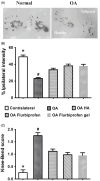Research progress on biodegradable polymer-based drug delivery systems for the treatment of knee osteoarthritis
- PMID: 40276032
- PMCID: PMC12018437
- DOI: 10.3389/fbioe.2025.1561708
Research progress on biodegradable polymer-based drug delivery systems for the treatment of knee osteoarthritis
Abstract
Knee osteoarthritis (KOA) is a disease that involves multiple anatomical and physiological changes in the knee tissues, including cartilage degeneration, bone remodelling and formation of bony encumbrances, which leads to clinical manifestations including pain, stiffness, swelling and limitation of knee function. Knee osteoarthritis is a chronic joint disease characterised by degenerative cartilage lesions and secondary osteophytes in the knee joint. The symptoms of knee osteoarthritis tend to progress slowly, and at this stage, the number of patients with KOA is increasing. However, due to the adverse effects and poor therapeutic outcomes following surgical treatment, intervention therapy through the utilisation of biodegradable polymeric materials is required. Currently, clinical aspects are mainly used to treat cartilage degeneration in patients with osteoarthritis of the knee by using different kinds of biodegradable biopolymer materials with excellent physical properties, histocompatibility and other properties, combined with a drug delivery system, which can reduce the level of inflammation and stiffness in the focal area, and maximise the restoration of the patient's knee joint joint mobility and athletic ability. Based on the properties of the polymeric material drug delivery system, the polymeric material has a variable drug loading capacity that encapsulates hydrophobic/hydrophilic drugs and controls the release kinetics by regulating the composition and charge. This paper reviews the research progress of Poly (ε-caprolactone) (PCL), Poly(lactic acid) (PLA), Poly (lactic glycolic acid) (PLGA), Poly(ethylene glycol) (PEG) synthetic polymers and collagen, chondroitin sulfate, other natural polymers based drug delivery systems for the treatment of knee osteoarthritis, and explains that different biodegradable polymeric materials have been widely used for the treatment of knee osteoarthritis. However, there are still issues of degradability, toxicity, compatibility, and durability and safety of the drug delivery system of degradable materials that need to be addressed in further clinical trials. As biodegradable biomedical materials continue to be explored, eventually idealized polymeric materials will stand out in the treatment of KOA.
Keywords: biodegradable polymers; drug delivery system; knee osteoarthritis; natural polymers; synthetic polymers; treatment.
Copyright © 2025 Zhang, Zhang, Li, Zhang and Meng.
Conflict of interest statement
The authors declare that the research was conducted in the absence of any commercial or financial relationships that could be construed as a potential conflict of interest.
Figures








Similar articles
-
Recent advances in polymeric microparticle-based drug delivery systems for knee osteoarthritis treatment.Front Bioeng Biotechnol. 2023 Dec 7;11:1290870. doi: 10.3389/fbioe.2023.1290870. eCollection 2023. Front Bioeng Biotechnol. 2023. PMID: 38130826 Free PMC article. Review.
-
Development of Targeted Nanoscale Drug Delivery System for Osteoarthritic Cartilage Tissue.J Nanosci Nanotechnol. 2018 Apr 1;18(4):2310-2317. doi: 10.1166/jnn.2018.14311. J Nanosci Nanotechnol. 2018. PMID: 29442897
-
Mechanical properties of biodegradable polymers and composites proposed for internal fixation of bone.J Appl Biomater. 1990 Spring;1(1):57-78. doi: 10.1002/jab.770010109. J Appl Biomater. 1990. PMID: 10148987 Review.
-
Biodegradable poly-D,L-lactic acid-polyethylene glycol block copolymers as a BMP delivery system for inducing bone.J Bone Joint Surg Am. 2001;83-A Suppl 1(Pt 2):S92-8. J Bone Joint Surg Am. 2001. PMID: 11314801
-
Biodegradable thermogels.Acc Chem Res. 2012 Mar 20;45(3):424-33. doi: 10.1021/ar200162j. Epub 2011 Oct 12. Acc Chem Res. 2012. PMID: 21992012
Cited by
-
Targeted therapy for knee osteoarthritis: From basic to clinics.Medicine (Baltimore). 2025 Aug 15;104(33):e43686. doi: 10.1097/MD.0000000000043686. Medicine (Baltimore). 2025. PMID: 40826764 Free PMC article. Review.
References
-
- Abdelhamid M. M., Eid G., Othman M. H. M., Ibrahim H., Elsers D., Elyounsy M., et al. (2023). The evaluation of cartilage regeneration efficacy of three-dimensionally biofabricated human-derived biomaterials on knee osteoarthritis: a single-arm, open label study in Egypt. J. Personalized Med. 13 (5), 748. 10.3390/jpm13050748 - DOI - PMC - PubMed
-
- Abou-ElNour M., Ishak R. A. H., Tiboni M., Bonacucina G., Cespi M., Casettari L., et al. (2019). Triamcinolone acetonide-loaded PLA/PEG-PDL microparticles for effective intra-articular delivery: synthesis, optimization, in vitro and in vivo evaluation. J. Control. Release 309, 125–144. 10.1016/j.jconrel.2019.07.030 - DOI - PubMed
-
- Aulin C., Melander-Bowden T., Erlandsson-Harris H., Engstrand T. (2023). Anti-inflammatory polymers as potential therapeutics in knee osteoarthritis. Osteoarthr. Cartil. 31, S26. 10.1016/j.joca.2023.01.513 - DOI
Publication types
LinkOut - more resources
Full Text Sources
Research Materials

